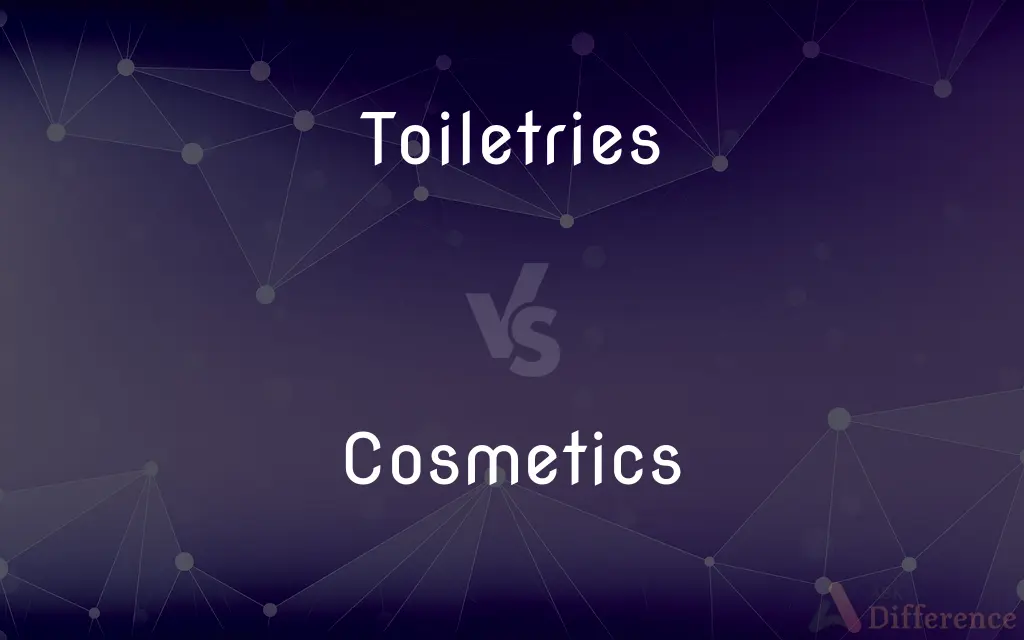Toiletries vs. Cosmetics — What's the Difference?
By Fiza Rafique & Maham Liaqat — Updated on April 22, 2024
Toiletries are essential hygiene products, including soap and toothpaste, whereas cosmetics, such as makeup and perfume, enhance appearance.

Difference Between Toiletries and Cosmetics
Table of Contents
ADVERTISEMENT
Key Differences
Toiletries are primarily designed for personal hygiene and cleanliness, typically including items like soap, shampoo, and toothpaste. Whereas cosmetics are used to enhance or alter one’s appearance, often encompassing products such as makeup, nail polish, and skincare items.
Toiletries are generally considered necessities in daily grooming routines, focusing on maintaining cleanliness and health. On the other hand, cosmetics are often seen as optional and are used to improve aesthetic appeal or cover imperfections.
The regulatory standards for toiletries are often focused on safety and efficacy since these products are used for cleaning and personal care. Meanwhile, cosmetics also undergo safety regulations, but there is an additional emphasis on aesthetic qualities and long-term skin impacts.
Toiletries often come in more straightforward packaging and formulations to meet everyday hygiene needs. Conversely, cosmetics may feature more elaborate packaging and diverse formulations to cater to different styles, occasions, and personal preferences.
While toiletries are used by a broad demographic, regardless of age or gender, cosmetics often target specific market segments based on age, gender, or cosmetic needs, reflecting varying trends and beauty standards.
ADVERTISEMENT
Comparison Chart
Primary Use
Hygiene and cleanliness
Enhancement of appearance
Typical Products
Soap, shampoo, toothpaste
Makeup, perfume, skincare
Regulatory Focus
Safety and efficacy
Safety, efficacy, and aesthetics
Packaging
Simple and functional
Often elaborate and varied
Target Demographic
Broad (all ages and genders)
Often specific (by age, gender)
Compare with Definitions
Toiletries
Soap.
Bar soap is commonly used for bathing and handwashing.
Cosmetics
Moisturizer.
Daily moisturizer helps maintain skin hydration.
Toiletries
Toothpaste.
Fluoride toothpaste helps prevent dental cavities.
Cosmetics
Lipstick.
Bright red lipstick is her signature for special occasions.
Toiletries
Deodorant.
He applies deodorant daily after his shower.
Cosmetics
Mascara.
Mascara enhances the eyelashes, making them appear longer and fuller.
Toiletries
Razor.
Disposable razors are convenient for travel.
Cosmetics
Foundation.
She applies foundation to create a smooth complexion.
Toiletries
Shampoo.
She uses a moisturizing shampoo for her dry hair.
Cosmetics
Eyeliner.
He uses eyeliner to accentuate his eyes.
Toiletries
Articles used in washing and taking care of one's body, such as soap, shampoo, and toothpaste
A range of toiletries
Men's toiletry sales
Cosmetics
Cosmetics are constituted from a mixture of chemical compounds derived from either natural sources, or synthetically created ones. Cosmetics designed for skin care can be used to cleanse, exfoliate and protect the skin, as well as replenishing it, through the use of cleansers, toners, serums, moisturizers, and balms.
Toiletries
An article, such as toothpaste or a hairbrush, used in personal grooming or dressing.
Cosmetics
A preparation, such as powder or a skin cream, designed to beautify the body by direct application.
Toiletries
Plural of toiletry
Cosmetics
Something superficial that is used to cover a deficiency or defect.
Toiletries
An artifact used in making your toilet
Cosmetics
Serving to beautify the body, especially the face and hair.
Cosmetics
Serving to modify or improve the appearance of a bodily feature, defect, or irregularity
Cosmetic therapy.
Cosmetics
Decorative rather than functional
Cosmetic fenders on cars.
Cosmetics
Lacking depth or significance; superficial
Made a few cosmetic changes when she took over the company.
Cosmetics
Preparations applied externally to change or enhance the beauty of skin, hair, nails, lips, and eyes.
Cosmetics
The study of such products.
Cosmetics
A toiletry designed to beautify the body
Common Curiosities
Do men use cosmetics?
Yes, cosmetics are used by people of all genders, including men, often for skin care or enhancing features.
Can cosmetics be used daily?
Yes, cosmetics can be used daily depending on personal preferences and needs.
Are toiletries considered cosmetics?
While both can be personal care products, toiletries are specifically for hygiene, unlike cosmetics, which are for aesthetic purposes.
What are the main purposes of toiletries?
Toiletries are used for cleaning and maintaining personal hygiene.
Are there natural alternatives to standard toiletries?
Yes, there are natural toiletries available that use organic and chemical-free ingredients.
How are cosmetics regulated differently from toiletries?
Cosmetics often face stricter color additive regulations and may have guidelines about claims regarding beauty enhancements.
What is an example of a cosmetic product that also has a toiletry function?
Tinted moisturizer acts as a hydrating skin care product while providing some coverage like a foundation.
Is it necessary to use toiletries every day?
For maintaining good personal hygiene, daily use of basic toiletries like soap and toothpaste is recommended.
Why might someone choose not to use cosmetics?
Reasons can include skin sensitivity, personal preference for a natural look, or the desire to avoid certain chemicals.
Can using toiletries cause skin problems?
Some individuals might experience skin issues if they are allergic to specific ingredients commonly found in toiletries.
What toiletries are essential for a basic hygiene routine?
Essential toiletries include soap, toothpaste, and deodorant.
How do the ingredients typically differ between toiletries and cosmetics?
Toiletries often contain more cleansing and antibacterial agents, while cosmetics might include more fragrances and colorants.
How has the use of cosmetics evolved over time?
Cosmetics have evolved from natural pigments to complex formulations designed for long wear, beauty enhancement, and skin care.
Share Your Discovery

Previous Comparison
Disconfirm vs. Confirm
Next Comparison
Clamor vs. ClamberAuthor Spotlight
Written by
Fiza RafiqueFiza Rafique is a skilled content writer at AskDifference.com, where she meticulously refines and enhances written pieces. Drawing from her vast editorial expertise, Fiza ensures clarity, accuracy, and precision in every article. Passionate about language, she continually seeks to elevate the quality of content for readers worldwide.
Co-written by
Maham Liaqat














































